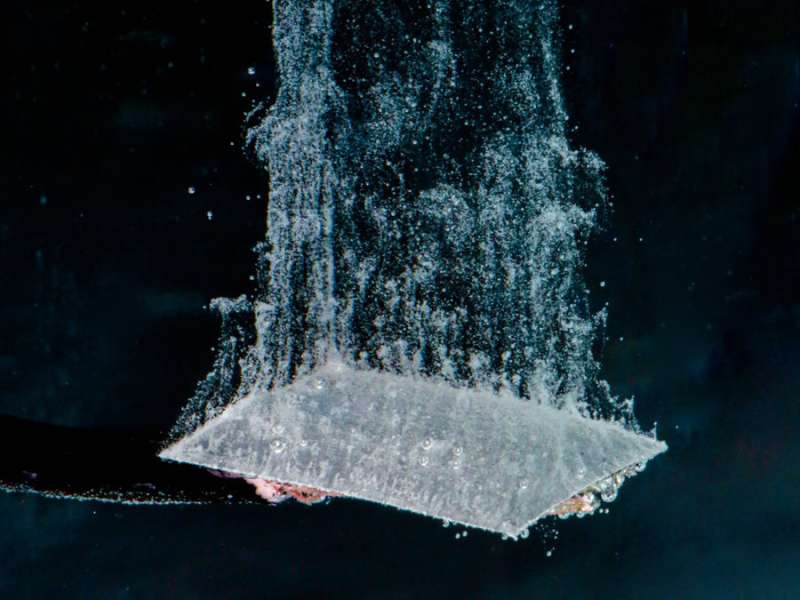The fundamental chemistry behind electrocatalytic water splitting

Transitioning to a sustainable energy economy requires electrocatalytic methods to convert electrical energy to chemical energy and feedstocks. A team of researchers from TU Berlin, ETH Zurich, the National Research Council—Institute of Materials of Trieste, and led by the FHI has now uncovered the reaction mechanism of a major bottleneck in these processes, the oxygen evolution reaction. Results are published in Nature.
Electrocatalytic oxygen evolution, the critical half-reaction of water splitting, is a keystone technology in the transition to a renewable energy economy. This is because, as the share of non-dispatchable renewable energy sources (such as wind and solar power) increases, energy storage solutions are needed to absorb intermittent power fluctuations and ensure a reliable energy supply. Of these, the conversion of electrical energy to chemical fuels by means of protons and electrons is among the most flexible since chemical fuels can be used when and where they are needed.
A major hurdle, however, has been finding electrocatalysts for the concomitant conversion of water to molecular oxygen, the oxygen evolution reaction, that provides the protons and electrons to make those fuels. In efforts to develop improved electrocatalysts, experts have long assumed that the electrocatalytic oxygen evolution reaction can be understood using a well-established, decades-old theory developed to describe non-catalytic electron transfer reactions. The team of researchers decided to test those assumptions and surprisingly found that the oxygen evolution reaction is actually more similar to traditional thermocatalysis than previously thought. This allows tools and concepts developed to describe traditional thermal catalysts to be applied to their electrochemical counterparts for the first time.
"It is important to understand the basic science behind electrocatalysts in order to improve them in the future. It was becoming increasingly clear to us that the traditional picture of what drives electrocatalytic reactions was incomplete," explains Peter Strasser, one of the co-authors from the Technical University of Berlin. He added, "Researchers typically assume the oxygen evolution reaction is controlled by the direct action of the electric potential on the reaction coordinate. That is a very different picture from thermocatalysis where chemical bond making and breaking controls rate through surface chemistry."
In a study published in Nature, the team reports how one of the most successful classes of oxygen evolution catalysts, iridium oxides, operates. They performed synchrotron-based operando X-ray spectroscopy at BESSY II in Berlin and Petra III in Hamburg to study how iridium oxides behave during electrocatalytic oxygen evolution. These experiments let them simultaneously monitor the electric potential and surface chemistry. They took what they learned in these experiments to build atomic-scale models of the catalyst surfaces, which were used in quantum mechanical simulations of the reaction at the High Performance Computing Center in Stuttgart.
"The simulations showed that the reaction rate depends exponentially on the surface coverage of the oxidative charge, in agreement with the measurements," says Travis Jones from the Fritz Haber Institute.
"The simulations also captured the change in Tafel slope, a key feature of iridium oxide, and ascribed it to a change in the response of the oxidative charge to the potential, rather than to a change in the mechanism, as previously thought," explains Simone Piccinin, a co-author from the National Research Council—Institute of Materials of Trieste, Italy. These studies led the researchers to suspect that the reaction was controlled by surface chemistry rather than the potential acting directly on the reaction coordinate.
By developing a lab-based method to quantify charge accumulation the team was able to screen a range of materials and found they all showed the same behavior. Detre Teschner from the Fritz Haber Institute explains: "It appeared that the role of the potential was to oxidize the surface and that the charge accumulating through this oxidation was controlling the reaction rate much like in thermal catalysis."
After seeing that charge appeared to mediate electrocatalytic rate the researchers sought a means of controlling catalyst charge independently from the potential to test their finding. "We needed a chemical way to change how much charge the catalysts could store and quickly realized we could do that by replacing some of the oxygen on the surface with chlorine since the chlorine cannot be oxidized to store extra charge," says Javier Pérez-Ramírez from ETH Zürich.
The Zürich team used their expertise in halogen chemistry to produce a series of catalysts with varying amounts of chlorine. As expected, the charge the catalysts could store varied with the amount of chlorine on them. Electrocatalytic testing of these new materials verified their behavior in the oxygen evolution reaction and matched the team's predictions. "Seeing how changing a catalyst's ability to store charge predictably altered its catalytic activity gave us confidence in the findings. We expect this result to apply to a vast class of electrocatalysts and we plan to use this new knowledge to design and test new materials," says Travis Jones from the Fritz Haber Institute.
More information: Hong Nhan Nong et al. Key role of chemistry versus bias in electrocatalytic oxygen evolution, Nature (2020). DOI: 10.1038/s41586-020-2908-2
Journal information: Nature
Provided by Max Planck Society





















